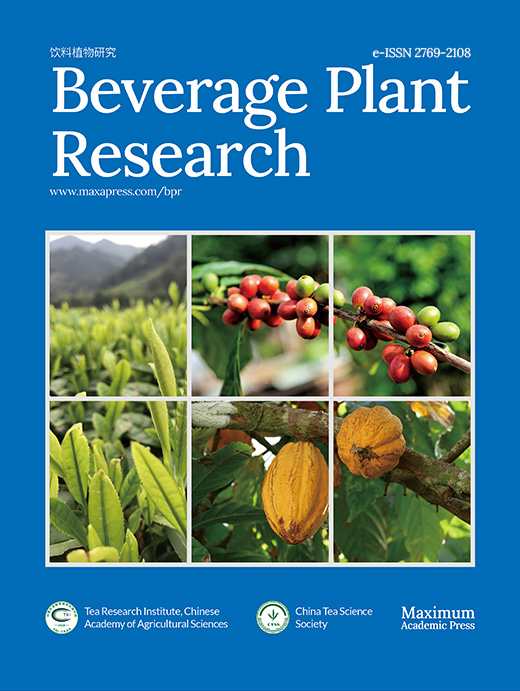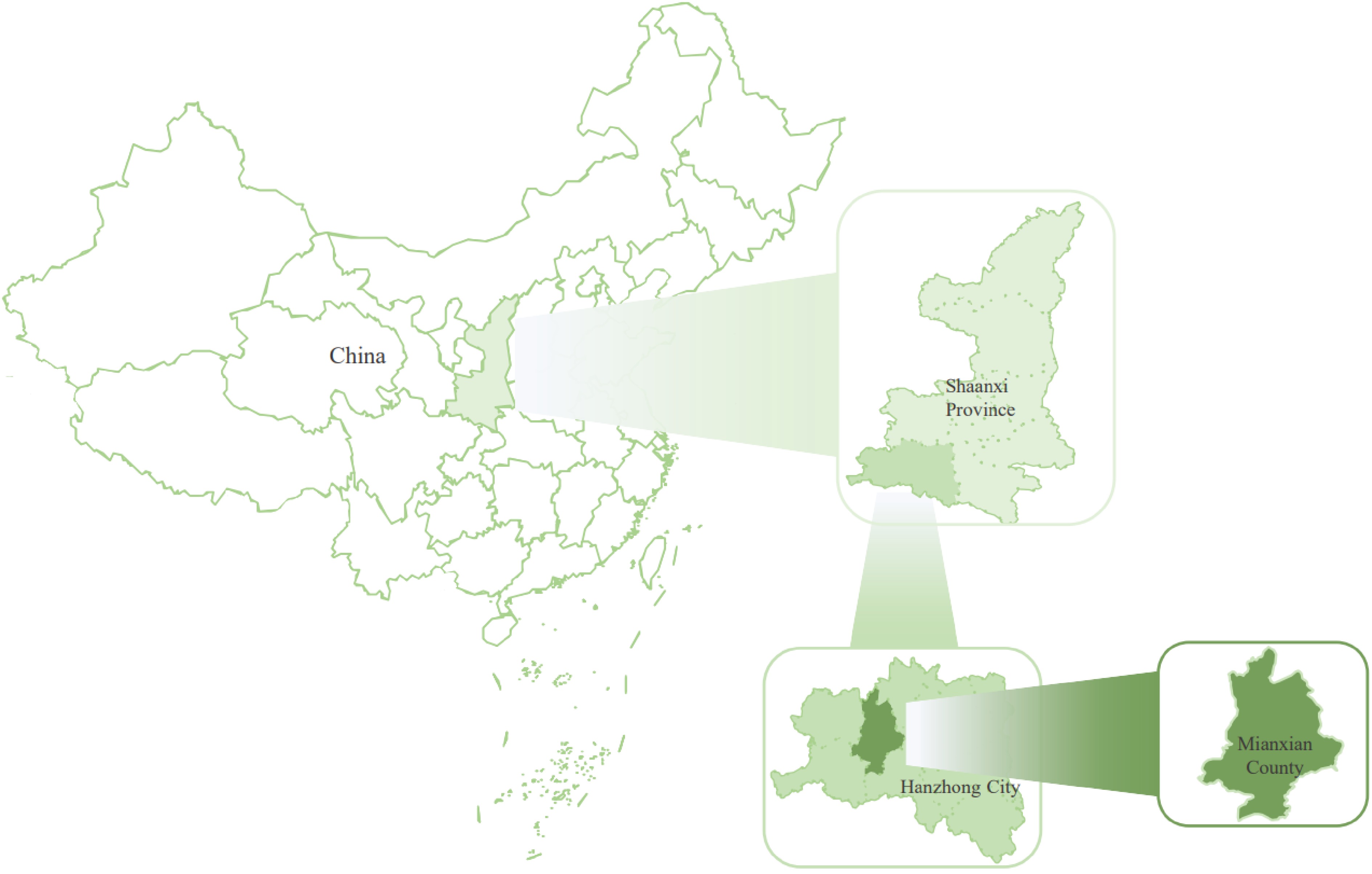-
Tea, the second most popular and economically important beverage in the world offers numerous health benefits such as antioxidants, and the prevention of hypertension[1]. The quality of fresh leaves is the foremost element in determining economic value. Moreover, the quality of fresh leaves largely depends on soil nutritional conditions. Indeed, fertilizer management is a crucial measure in producing high-quality tea, particularly in the Jiangbei region of the southern Shaanxi Province, which is the core spring tea-producing region in China. Of late, the summer and autumn tea has also gained much attention in these regions. Considering the prominent contradiction between yield and quality faced by industrial development, a fertilization management strategy suitable for northern alpine summer tea cultivation was explored.
In the southern Shaanxi Province, the soils are characterized by low organic matter content, ranging from 0.96–43.34 g·kg−1[2]. Therefore, the adoption of an organic-based fertilization system is urgently needed to improve soil health, enhance nutrient utilization efficiency, and promote high-quality tea production in these areas. The addition of organic fertilizers improves soil physiochemical properties including soil porosity and organic carbon content[3]. Moreover, organic fertilizers also support sustainable agricultural development due to their slow release of nutrients[4]. The soil of the experimental site, Xiaohemiao Village in Mianxian County, has a low pH, which poses a major problem in successful tea cultivation and production. On the other hand, organic fertilizers contain free hydroxyl groups, which can somehow alleviate soil acidification[5]. In bioorganic fertilizers, microbial agents contain a sufficient amount of organic matter and beneficial microorganisms that improve the soil microenvironment, increase soil enzymatic activity, and improve overall soil fertility. These conditions ultimately lead to increased crop yield[6]. Thus, the incorporation of bioorganic fertilizers would be an imperative solution to improve the soil conditions of tea plantation regions in southern Shaanxi (China).
Reducing the application of inorganic N fertilizer is the primary direction to achieve green development goals. To date, no precise N management guidelines have been suggested for these important tea-producing areas. Some studies have also suggested that in pursuit of high yield, excessive N fertilization is commonly practiced, which, in turn, results in soil acidification. According to an estimate, the average amount of N fertilizer applied in major tea-producing areas in China is 600 kg N hm−2[7]. Excessive use of N fertilizer not only results in high input costs but also inevitably reduces nutrient utilization efficiency, damages soil quality, contributes to soil acidification, and diminishes soil buffering capacity[8]. Moreover, improper use of N fertilizer also leads to increase in greenhouse gas emissions and other soil and environmental problems[9]. The Mianxian tea plantation region has low-moderate soil N content and its utilization efficiency. Therefore, bioorganic fertilizers with large surface areas offer a sustainable solution to reduce N losses and enhance overall utilization efficiency.
Reducing inorganic N application along with increasing the use of bioorganic fertilizers has been reported to have significant promise for achieving ecological nutrient balance and efficiency. It is estimated that about 1 million tons of applied fertilizer are wasted in China each year, highlighting the urgency of replacing chemical fertilizers with microbial fertilizers to effectively improve their utilization and alleviate the pressure on the ecological environment[10]. While bioorganic fertilizers can provide plants with the required nutrients for an extended period, their nutrient release rate is slow. In contrast, chemical fertilizers have a quick effect and are easily absorbed and utilized by plants. Overall, the reduced application of N fertilizer based on bioorganic fertilizer will be an effective measure that can regulate the nutrient release rate effectively, improve soil health, and enhance nutrient utilization rates by tea plants.
To support China's Carbon Peak and Carbon Neutrality policy and implement the double reduction policy of fertilizer and pesticide, our study designed seven treatments based on reducing chemical N and incorporating bioorganic fertilizers to explore their effects on the yield and quality of summer tea. In this study, we hypothesized that reducing chemical N fertilizers while increasing bioorganic fertilizers, applied as a basic dose in autumn and top dressing in spring would promote soil health, tea quality, and yield in the Mianxian tea plantation region.
-
The experimental site is located in the alpine tea plantation of Xiaohemiao Village, Mianxian County, Hanzhong City, Shaanxi Province (106°41'17.82" E longitude, 32°57'1.13" N latitude, 1,000–1,300 m alt.), China (Fig. 1). The site has a subtropical monsoon climate with obvious vertical climate differences and an annual average temperature and precipitation of 14.3 °C and 900 mm, respectively. Precipitation in this region is mainly concentrated in the summer and autumn seasons. The annual average frost-free period is 233 d. The soil type is yellow-brown soil. The basic soil nutrient is: pH 4.18, organic matter 18.29 g·kg−1, alkaline nitrogen 99.8 mg·kg−1, available phosphorus 4.35 mg·kg−1, rapidly available potassium 216 mg·kg−1, exchangeable magnesium 0.50 cmol·kg−1. Soil fertility is moderate to low. The tea variety used in this study was the 'Ziyangzhong', aged over 30 years. The seedlings were planted in double rows with 1 m distance between the rows. Manual picking was done for tea leaf harvesting. Fertilization management included only a base fertilizer application in the autumn season and top dressing in the spring season.
The organic fertilizer used in the experiment (with an organic matter content ≥ 45% and N + P2O5 + K2O ≥ 5%) was provided by China Shaanxi Ruihao Biological Co., Ltd. The nitrogen content of organic fertilizer was 3%. Microbial agents (Bacillus licheniformis, B. mucilaginosus, and B. amyloliquefaciens) were all solid inoculants provided by China Shaanxi Ruihao Biological Co., Ltd. The effective viable bacterial count of these agents was ≥ 1.0 × 108 CFU g−1.
The experiment was comprised of seven treatments including no fertilizer (N-CK), sole chemical N fertilizer at 450 kg N hm−2 (N-1), sole organic fertilizer (N-2), bioorganic fertilizer with the addition of three types of microbial agents (N-3), bioorganic fertilizer + chemical N application at 300 kg N hm−2 (N-4), 600 kg N hm−2 (N-5) and 900 kg N hm−2 (N-6). Chemical N fertilizer was applied in the form of large particle urea. The amount of organic fertilizer was 6,000 kg·hm−2, and the amount of each of three microbial agents was 6 kg·hm−2, respectively. Each treatment was set up with three replicates and followed a random block arrangement design. The area of each plot was 48 m2 (8 m × 6 m). During the observation period, all organic fertilizer and microbial agents were applied as a base fertilizer dose in mid-to-late September 2022, while only 40% of N fertilizer was applied as a base fertilizer and the remaining 60% was applied as topdressing fertilizer from late February to early March 2023. The specific fertilization plan is shown in Table 1.
Table 1. Nitrogen fertilizer application systems based on bioorganic fertilizers.
Treatment Base fertilizer (mid-to-late September 2022) Additional fertilizer (late February – early March 2023) N Organic fertilizer Microbial agents N Organic fertilizer Microbial agents N-CK — — — — — — N-1 180 — — 270 — — N-2 — 6000 — — — — N-3 — 6000 6+6+6 — — — N-4 120 6000 6+6+6 180 — — N-5 240 6000 6+6+6 360 — — N-6 360 6000 6+6+6 540 — — — means no fertilization. Soil sampling and analysis
-
Soil samples were collected in late June 2023. In each experimental plot, soil samples from the 0–20 cm rhizospheric soil layer were collected using the five-point sampling method. The soil bulk density and moisture content were measured immediately after sampling. Later, naturally air-dried and sieved samples were used to determine physicochemical properties.
Determination of physical and chemical properties of tea plantation soil:
The moisture soil contents were determined using the drying method[11]. Soil bulk density was measured using the cutting ring method[12]. Soil pH was measured using the sartorius acidimeter (PB-10) based on electrode potential method[13]. The potassium dichromate-sulfuric acid external heating method was used for soil organic matter[14]. Soil alkaline hydrolysis N content was determined based on the alkaline hydrolysis diffusion method[14]. Soil available phosphorus content was determined using the molybdenum antimony colorimetric method[14]. The available potassium content of the soil was measured using the flame photometer method[14]. The soil exchangeable magnesium content was estimated by the ammonium acetate exchange-atomic absorption method[14].
Nitrogen utilization efficiency was calculated according to the following formula[15]
-
$ \rm{N}itrogen\; partial\; factor\; productivity=\dfrac{Tea\; seedling\; yield}{N\; application} $ $ \begin{split} & \rm{N}itrogen\; fertilizer\; contribution\; rate= \\ &\rm{\dfrac{(Yield\; in\; N\; supplemented\; plots-Yield\; in\; control\; plots)}{Yield\; in\; N\; supplemented\; plots}}\times 100\text{%} \end{split} $ ${\begin{split}&\rm Physiological\; N\; utilization\; efficiency =\\&\rm\dfrac{ (Yield\; in \;N\; supplemented\; plots - Yield\; in\; control\; plots)}{ (Leaves\; N \;uptake \;in \;N \;supplemented \;plots - Leaves\; N\; uptake\;in \;control \;plots)} \end{split}}$ $ \begin{split} & \rm{A}gronomic\; N\; use\; efficiency= \\ &\rm{\dfrac{(Yield\; in\; N\; supplemented\; plots-Yield\; in\; control\; plots)}{N\; application\; rate}} \end{split} $ Growth indicators were determined as follows
-
The height and crown breadth of tea plants were measured with a tape measure. Leaf area (LA) was calculated using the formula: LA = leaf length × leaf width × 0.7. The number of new shoots sprouting from tea plants in each sample plot represented the germination density and shown as bud/m2. The method for determining 100-bud involved picking one bud and two leaves of 20 tea plants in each treatment line and then converting to 100-bud weight after weighing. The yield was calculated as the weight of one individual bud and two leaves multiplied by the number of the bud per unit area and the plot area.
Determination of plant components
-
Samples of the tea plant bud, 1st leaf, and 2nd leaf were manually picked in late June 2023 and stored at −80°C after freezing in liquid nitrogen. Ground samples were used to measure nitrate reductase and glutamine synthetase activity, dry matter, tea polyphenols, water extracts, caffeine, free amino acids, malondialdehyde, proline, and soluble protein content using an ultraviolet spectrophotometer.
Determination of key enzyme activities in nitrogen metabolism:
Nitrate reductase activity was measured using an in vitro method[16]. Plant glutamine synthetase activity was determined according to the method outlines in the 'Handbook of Plant Physiology Experiments'[17].
Determination of tea quality components
-
The dry matter, polyphenol, and water extract contents were measured according to the national standard GB/T 8303-2013[18], GB/T 8313-2018[19], and GB/T 8305-2013[20] methods, respectively. The caffeine content was measured according to the national standard (GB/T 8312-2013) method[21]. The free amino acid content was determined according to the national standard (GB/T 8314-2013) method[22].
Determination of tea resistance indicators
-
The malondialdehyde contents were determined based on the thiobarbituric acid method[23]. Proline content was determined using the acid ninhydrin method[24]. Soluble protein content was determined using the Coomassie brilliant blue method[25].
Data analysis
-
Statistical analyses were done using Microsoft Excel 2016. The Pearson method was used to analyze the correlation between variables at significant levels of p ≤ 0.05, p ≤ 0.01 and p ≤ 0.001. Graphical presentations were made with Origin 2021, GraphPad Prism 8.0.2 and ChiPlot online software.
-
Nitrogen fertilizer reduction based on bioorganic fertilizers improved soil physical properties. The tea plantation soil moisture content in summer was highest under the N-4 treatment (Fig. 2a), indicating that top-dressing in spring after applying base fertilizer in autumn is more conducive to soil water storage and moisture conservation in summer. The soil bulk density in summer was lowest under the N-3 treatment, about 34% lower than that under the CK treatment (Fig. 2b). The soil porosities increased in the following order: N-3 > N-2 > N-4 > N-5 > N-6 > N-1 > CK (Fig. 2c), suggesting that organic fertilizer improved the root's ability to absorb nutrients by increasing soil aeration.
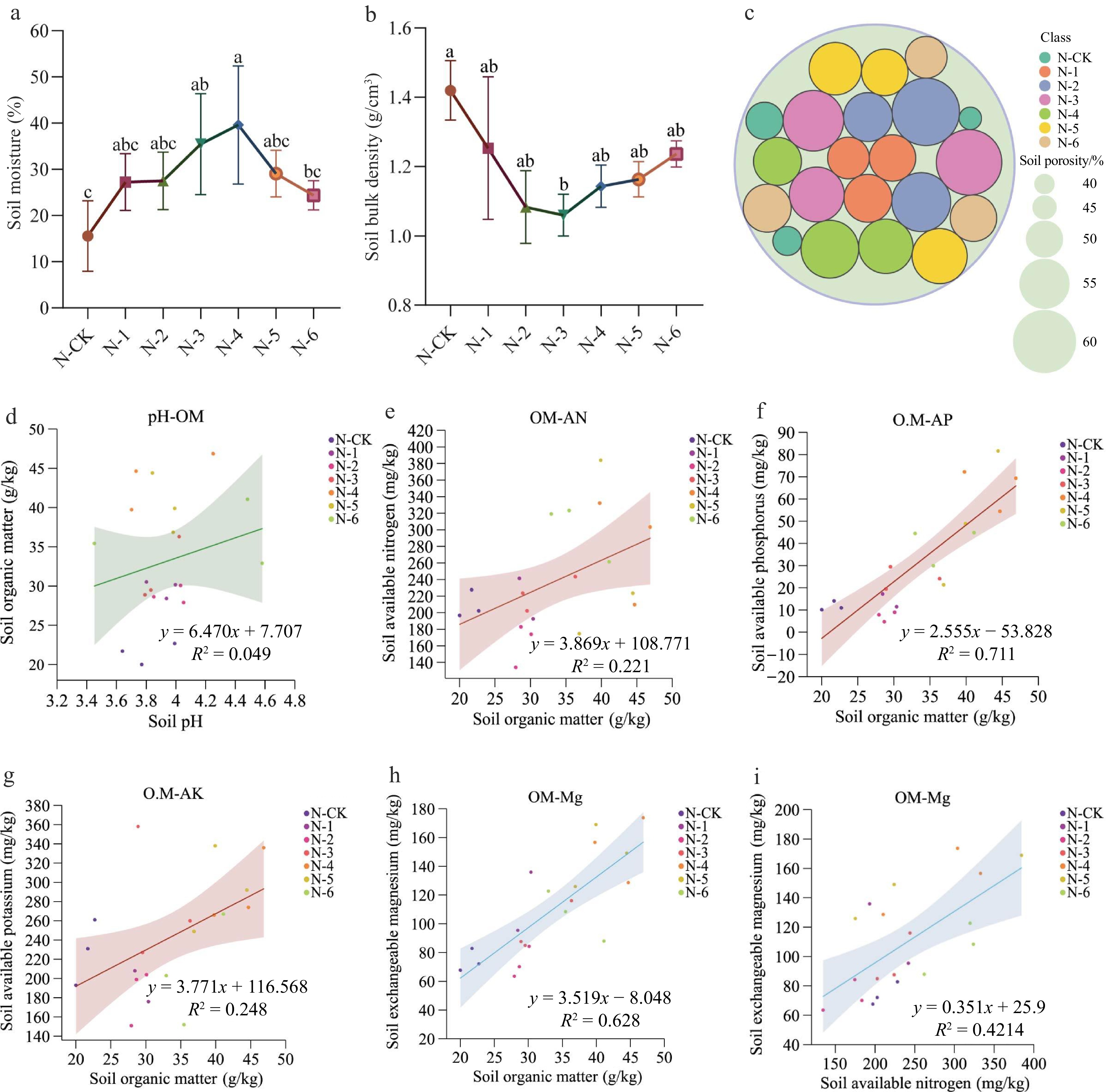
Figure 2.
Effect of nitrogen fertilizer reduction based on bioorganic fertilizer on the physicochemical properties including (a) soil moisture content, (b) soil bulk density, (c) soil porosity in summer under different fertilization treatments. Correlation relations are between (d) soil pH and organic matter, (e) soil organic matter and alkaline hydrolyzable nitrogen, (f) soil organic matter and available phosphorus, (g) soil organic matter and available potassium, (h) soil organic matter and exchangeable magnesium, and (i) between alkaline hydrolyzable nitrogen and exchangeable magnesium content in soil in summer.
Topdressing N in spring after applying bioorganic fertilizer in autumn significantly increased soil organic matter and fast-effective nutrient content in summer. The soil pH of the experimental site is generally low in the summer. A positive correlation between soil organic matter content and soil pH in summer was observed, with a correlation coefficient of 0.22. That indicates that as the soil pH increases within the range suitable for the growth of tea plants, the organic matter in the soil accumulates (Fig. 2d). Compared with the control and sole chemical N treatment, the application of bioorganic fertilizer was more conducive to increasing the soil organic matter content in the summer. The soil organic matter content was the highest under the N-4 treatment, indicating that reducing N fertilizer application can improve soil organic matter content. The contents of soil alkaline hydrolyzable N, available phosphorus, and fast-effective potassium in summer are positively correlated with the soil organic matter content, with correlation coefficients of 0.47, 0.84, and 0.50, respectively (Fig. 2e−g). The exchangeable magnesium content in summer is positively correlated with the soil organic matter content and alkali-hydrolyzable N content. The soil exchangeable magnesium content increased with the increase in soil organic matter and alkali-hydrolyzable N content (Fig. 2h & i). It is suggested that reducing N fertilizer based on bioorganic fertilizer can, in turn, promote chlorophyll synthesis, photosynthetic growth, and vegetative growth of tea plants in summer.
Nitrogen fertilizer reduction measures based on bioorganic fertilizers effectively improve the nitrogen use efficiency and yield of summer tea
-
Nitrogen fertilizer reduction based on bioorganic fertilizers improved N use efficiency in summer. The partial productivity of N fertilizer was the highest for the N-4 treatment and the values decreased with increasing N dose. The N fertilizer contribution rate was the highest under the N-5 treatment, significantly higher than the N-1 and N-6 treatments, followed by the N-4 treatment, but the difference between the two was not significant. The physiological utilization rate of N fertilizer was the highest under the N-5 treatment which was at par with the N-4 treatment. The agronomic utilization rate of N fertilizer showed a downward trend with the increase in N application rate. The agronomic N utilization rate under the N-4 treatment was significantly higher than that of other treatments in summer (Fig. 3). Therefore, moderate chemical N dose combined with bioorganic N sources was more conducive to enhancing N utilization and ultimately yield and outputs.
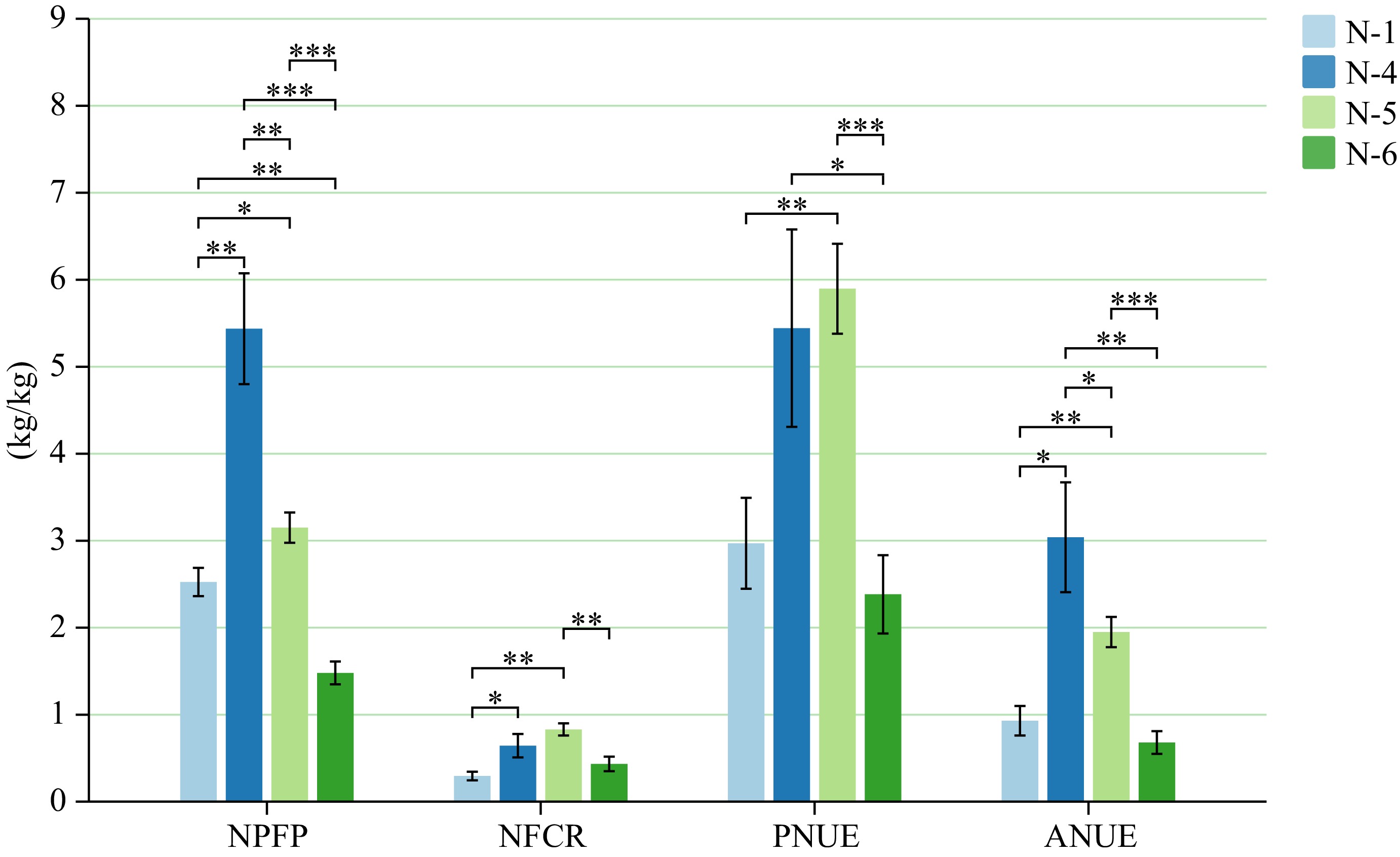
Figure 3.
Effect of nitrogen fertilization treatments nitrogen use efficiency in summer tea. Note: *, ** and *** significant at p ≤ 0.05, p ≤ 0.01 and p ≤ 0.001.
Nitrogen fertilizer reduction based on bioorganic fertilizers improved tea growth in summer and significantly promoted bud and leaf yield. The N-5 treatment depicted significantly higher plant height, followed by the N-4 treatment, compared with the N-1, N-3, and N-6 treatments (Fig. 4a). The crown breadth treated with bioorganic fertilizers was significantly higher than that of the CK treatment. The highest values were recorded for the N-5 treatment, followed by the N-4 treatment, which was significantly higher than that of sole chemical N application (Fig. 4b). The leaf area of the 3rd leaf under the N-4 and N-5 treatments was significantly larger than that of the CK and N-3 treatments (Fig. 4c). The germination densities in all chemical N treatments and sole bioorganic application (N-3) were significantly higher when compared with the CK treatment. The N-4 and N-5 treatments depicted significantly higher values of the second-round germination density than that of N-3 and N-6 treatments (Fig. 4d). The 100-bud weight under the N-4 and N-5 treatments was significantly higher than that of the CK treatment. Among them, the 100-bud weight under the N-5 treatment was the highest and significantly higher than that of the high N treatment (Fig. 4e). The tea yield under all chemical N treatments and sole bioorganic application (N-3) was significantly higher, over CK treatment. The tea yield under the N-4 and N-5 treatments was significantly higher than that of the N-1, N-2, and N-3 treatments. However, the difference between the N-4 and N-5 treatments was not significant (Fig. 4f). These results indicate that applying more N does not necessarily lead to higher growth and yield of the tea. This serves as a prominent example of 'too much is as bad as too little' in tea plantation management.
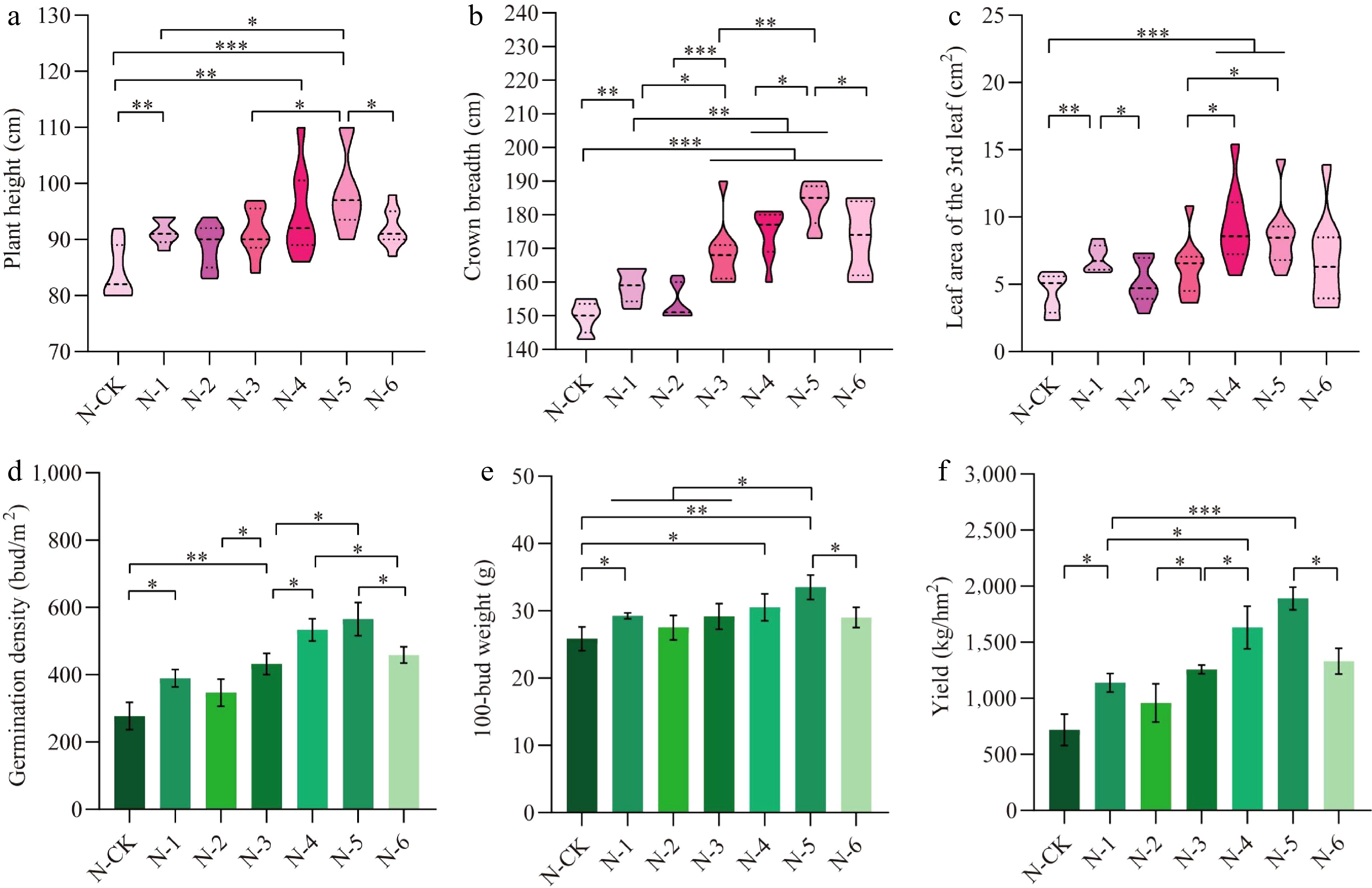
Figure 4.
Effect of nitrogen fertilizer management treatments on (a) tea plant height, (b) plant crown breadth, (c) leaf area of the 3rd leaf, (d) germination density, (e) 100-bud weight of one bud and two leaves of summer tea plants, and (f) yield of one bud and two leaves of tea plants. Note: *, ** and *** significant at p ≤ 0.05, p≤ 0.01 and p ≤ 0.001, respectively.
Nitrogen fertilizer reduction measures based on bioorganic fertilizers are beneficial in improving the activities of summer tea nitrate reductase and glutamine synthetase and effectively improving the quality ingredients of summer tea
-
Reducing N fertilizer application based on bioorganic fertilizer improved nitrate reductase and glutamine synthetase activities. The highest nitrate reductase activity in bud and 1st leaf was observed under the N-4 treatment, while for the 2nd leaf, it was highest under the N-5 treatment. There are significant differences in the glutamine synthetase activity under different fertilization treatments. The highest glutamine synthetase activity in tea buds was recorded for the N-4 and N-5 treatments. For the 1st leaf, the highest glutamine synthetase activity was observed under the N-5 treatment, while for the 2nd leaf, the highest values were observed for the N-4 treatment (Fig. 5a).
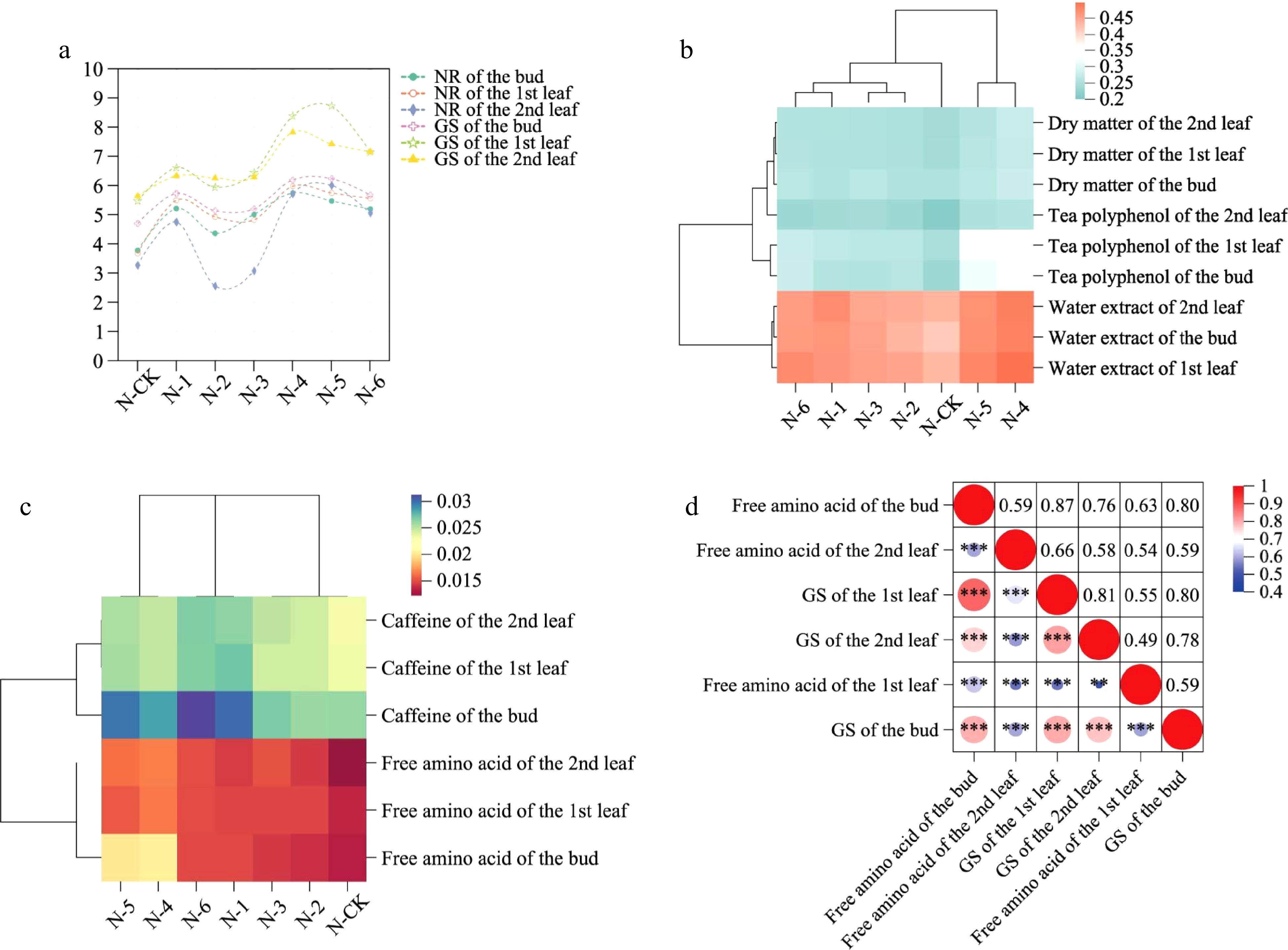
Figure 5.
Effect of reducing nitrogen rates based on bioorganic fertilizer on nitrate reductase, glutamine synthetase activities and quality traits of summer tea. (a) Activities of N metabolizing enzymes nitrate reductase and glutamine synthetase. (b) Dry matter, tea polyphenols, and water extract contents. (c) Caffeine and free amino acid content. (d) Correlation between free amino acid and glutamine synthetase activity. Note: *, ** and *** significant at p ≤ 0.05, p ≤ 0.01 and p ≤ 0.001.
The application of lower chemical N fertilizer combined with bioorganic fertilizer significantly improved the quality traits, with the highest values recorded for N application at 300 kg N hm−2 combined with bioorganic fertilizer. After fertilization, the maximum dry matter content of the tea bud, 1st leaf, and 2nd leaf was recorded for the N-4 treatment which increased the values by 10%, 13%, and 15%, respectively, over the control. Similarly, N-4 treatment also recorded significantly higher polyphenol content in the tea bud and 2nd leaf. However, polyphenol content depicted a decreasing trend with increasing the N fertilizer application rate. Moreover, the polyphenol content of the 2nd leaf was lower than that of the bud and 1st leaf. Among all N treatments, the lowest water extract content in tea bud was recorded for the N-2 treatment. On the other hand, N-4 treatment depicted significantly higher water extract content in tea bud, 1st leaf, and 2nd leaf, which increased the values by 16.1%, 15.7%, and 12%, respectively, over control (Fig. 5b). Among all N treatments, N-4 treatment showed a significant decline in caffeine content in tea bud, 1st and 2nd leaves. A similar pattern was observed for free amino acids, with the N-4 treatment showing significantly higher values, followed by the N-5 treatment. The N-2 treatment increased free amino acid in tea bud, 1st leaf, and 2nd leaf by 5.5%, 8.9%, and 16.4%, respectively, over the CK treatment (Fig. 5c). There was a strong correlation between free amino acids and glutamine synthetase activity (Fig. 5d). These findings suggested that reducing chemical N fertilizer application is crucial in controlling the formation of excellent-quality tea with low caffeine and high amino acids concentrations.
Nitrogen fertilizer reduction based on bioorganic fertilizer is beneficial for summer tea to enhance resistance
-
Applying bioorganic fertilizer and reducing chemical N dose proved effective in reducing oxidative damage caused by intense light and high-temperature stress during summer. The malondialdehyde content in tea bud, 1st leaf, and the 2nd leaf was observed under the N-3 treatment, showing a decrease of 23.8%, 20.6%, and 19.6%, respectively, compared with the CK treatment. The lowest malondialdehyde content in these plant organs was depicted for the N-4 and N-5 treatments. The highest soluble protein content in the bud and 2nd leaf was observed in the N-4 and N-5 treatments. For the 1st leaf, the highest soluble protein content was recorded in the N-5 treatment, followed by the N-4 treatment. While the high N fertilizer treatment was most beneficial for the proline content in the bud, 1st leaf, and 2nd leaf among all N application treatments, the associated costs were considerably higher (Fig. 6).

Figure 6.
Effect of reducing nitrogen rates based on bioorganic fertilizer on stress related indices in tea organs. (a) Malondialdehyde, proline, and soluble protein contents in the bud. (b) Malondialdehyde, proline, and soluble protein contents in the 1st leaf. (c) Malondialdehyde, proline, and soluble protein contents in the 2nd leaf.
-
Sustained soil physicochemical properties play an important role in improving soil quality and supporting normal plant growth[26]. Application of organic fertilizers is the most effective measure to improve soil fertility and microbial community structure over the long term[27]. The combined application of bioorganic and chemical fertilizers can effectively stabilize the soil properties and provide sufficient nutrients for better crop growth. Microbial agents from the Bacillus family, including Bacillus licheniformis, Bacillus mucilaginosus and Bacillus amyloliquefaciens can effectively inhibit the growth of certain plant pathogens and enhance plant resistance due to the secretion of antibiotics, active substances, and secondary metabolites such as iturin, surfactin, and fengycin, which have strong resistance to different pathogens[28]. According to Zhou et al., organic fertilizers increase soil water content, organic matter, and porosity, and reduces soil bulk density. However, sole chemical fertilizer application results in compacted soil particles, thus, in turn, reducing soil water content and porosity[29]. Moreover, the combined application of organic and inorganic N fertilizers have also been reported to improve soil nutrient supply, ensure efficient plant growth, and enable rational distribution of dry matter for better harvest index and yield[30]. Interestingly, Hooks et al. reported significantly similar above-ground fresh and dry weights of lettuce under organic fertilizers enriched with microbial inoculants and a control treatment without any amendment. However, organic fertilizer without any microbial inoculant resulted in 17% lower values of these traits in lettuce[31]. For soil properties, some previous studies have found that the combined application of organic and inorganic fertilizers can increase soil pH and enhance soil acid-base buffering capacity[32]. In this work, no significant effect of chemical N and bioorganic fertilizer on soil pH in Mianxian County was found. This might be explained by the fact that the application of whole N as base fertilizer dose increases soil pH, while top-dressing decreases the pH.
The right amount of N is conducive to normal tea growth and development, as well as achieving reasonable yield and quality[33]. However, excessive N application results in higher retention of assimilates in leaves and new shoots, thereby adversely affecting root growth. Similarly, an excessive dose of N also leads to a decline in nutrient utilization efficiency, increased input costs, nitrate pollution, and poses a hazard to the ecological environment[34]. Recently, Pan et al. showed that a moderate reduction in N can improve crop productivity. This improvement is linked to enhanced soil physicochemical conditions, that promoted the elongation and growth of the root. This facilitates increased absorption and transportation of nutrients by the root system, leading to greater accumulation of dry matter in stems and leaves. Consequently, this enhancement contributes to increased N partial factor productivity[35]. Previously, numerous studies indicated a positive correlation between tea polyphenol content and the amount of N applied[36,37]. However, a high N supply has been shown in some experiments to increase the allocation of photosynthetic assimilation towards protein synthesis in the tea plant, consequently reducing the conversion to polyphenols. This decrease in polyphenol content and water extract proves detrimental to the quality of black tea[38,39]. The results of this experiment are consistent with previous studies. The amino acids in tea greatly influence its sensory characteristics. Therefore, the amino acid content in tea serves as a crucial indicator of tea quality, directly impacting the profitability. N application significantly influences the amino acid contents in tea. Excessive nitrogen tends to result in tea leaves with a dominant presence of arginine and lower levels of theanine. As arginine imparts a bitter and astringent taste, this imbalance adversely affects tea quality[40,41].
In recent years, due to global warming, the frequency of extreme summer heat, drought, and other disasters has increased significantly. Currently, tea plantation diseases triggered by these climatic disasters have severely affected the growth and development of tea plants, leading to a decline in the quality of tea leaves. Malondialdehyde, a byproduct of lipid peroxidation, serves as an indicator of the extent of oxidative damage to cell membranes[42]. In this study, reducing the chemical N dose based on bioorganic fertilizers resulted in reduced malondialdehyde content and increased resistance in tea plants to summer conditions. Soluble proteins play a crucial role in maintaining the normal morphology of plant cells. Serving as important nutrients, they also function as osmoregulatory substances and are often used as a measure of plant stress tolerance[43]. In this work, reducing the chemical N dose based on bioorganic fertilizers favored the accumulation of soluble protein in tea plants. Similarly, proline also acts as an osmoregulatory substance in crop plants. Under stress conditions, proline helps eliminate various free radicals produced during adversity, participates in plant N metabolism, and releases energy. It can also act as a signaling molecule to induce other biochemical reactions[44]. While the high N fertilizer treatment based on bioorganic fertilizers in this study was more beneficial for the accumulation of proline in tea plants compared to other N treatments. It can also improve stress tolerance, but it will increase the cost. Therefore, considering this factor, lower concentrations of N based on bioorganic fertilizers remain more effective in reducing the damage of summer stress on tea plants.
In conclusion, establishing a scientific and balanced pattern of base fertilizer and top dressing is crucial for ensuring both tea yield and quality. In southern Shaanxi tea plantations, the application of base fertilizer, often containing a certain amount of N, has been prioritized for many years. Typically, nitrogen fertilization is reduced or even discontinued in early spring, following the autumn application. The results of this study indicate that supplementing with bioorganic fertilizer in autumn and applying moderate N fertilizer at least once in spring significantly enhances both the yield and quality of summer tea. This model serves as an exemplary approach for the scientific, cost-effective, and efficient application of N fertilizer in northern tea plantations.
-
The combination of reduced chemical N dose (300 kg N hm−2) with bioorganic fertilizer not only effectively improves soil fertility in the summer alpine tea plantation but also enhances yield, N utilization efficiency, and facilitates increased nitrate reductase and glutamine synthetase activities. These factors promote nutrient accumulation in the tea and enhance the resistance to harsh summer conditions. A study by Dai et al. showed that the amount of nitrogen fertilizer application differentially affects soil fertility of tea plantations with different fertilities: when tea plantations with low fertility are applied with 300 kg·hm−2 nitrogen and those with high fertility are applied with 150 kg·hm−2 nitrogen, the contents of carbon and nitrogen nutrients are relatively high[45]. In tea plantation management, proper fertilizer application according to local conditions is an essential measure to improve soil fertility. Our field research on soil organic matters of northern tea plantations showed that the content of soil organic matter in Motuo County is relatively high, followed by that of Chayu County. The content in Mianxian County is relatively low, which is 18.29 g·kg−1, ranking as the level 4 in national soil nutrient content. More tea plantations have relatively lower organic matter content due to nutrient leaching in mountainous terrain, which constrains the development of the tea industry. Moreover, the content of alkaline nitrogen of soil in Mianxian County is 99.8 mg·kg−1, ranking as level 3 in national soil nutrient content[46]. There is a lot of room for improvement in nitrogen utilization efficiency. Therefore, the nitrogen application of 300 kg N hm−2 is not too high, given that the soil fertility is relatively low in Mianxian County as the northern tea plantations and nutrient leaching is likely to occur in mountain tea plantations. Hence, this N management model is worthy of further promotion in tea plantations facing soil acidification in the north. Additionally, it can serve as a quarterly fertilizer management reference for most tea plantations with acidified soils in the south.
-
The authors confirm contribution to the paper as follows: study conception and design: Gong C, Bai J, Shi R, Wang Y, Chen E, Wang C; experiments performed: Shi R, Wang Y, Zhou F, Chen E; data analysis: Shi R, Wang Y, Zhou F; draft manuscript preparation: Shi R, Hussain S, Lei X. All authors reviewed the results and approved the final version of the manuscript.
-
Due to administrative requirements, the original data of the experiments during the research period of the project are not available to the public, but available from the corresponding author or the first author upon reasonable request.
This research was supported by Key Research and Development Project of the Tibetan Autonomous Region Department of Science and Technology (XZ202401ZY0019) and the Key Agricultural Core Technology Research Project of Agriculture and Rural Affairs Department of Shaanxi Province (2023NYGG009).
-
The authors declare that they have no conflict of interest.
- Copyright: © 2024 by the author(s). Published by Maximum Academic Press, Fayetteville, GA. This article is an open access article distributed under Creative Commons Attribution License (CC BY 4.0), visit https://creativecommons.org/licenses/by/4.0/.
-
About this article
Cite this article
Shi R, Wang Y, Zhou F, Hussain S, Lei X, et al. 2024. Nitrogen fertilizer reduction based on bioorganic fertilizer improves the yield and quality of fresh leaves of alpine tea in summer. Beverage Plant Research 4: e035 doi: 10.48130/bpr-0024-0024
Nitrogen fertilizer reduction based on bioorganic fertilizer improves the yield and quality of fresh leaves of alpine tea in summer
- Received: 27 April 2024
- Revised: 16 May 2024
- Accepted: 05 June 2024
- Published online: 09 October 2024
Abstract: Nitrogen (N) fertilizer management is pivotal for guaranteeing higher yield and better quality of crops. In recent years, significant efforts have been devoted to enhancing N-use efficiency in field crops. However, comprehensive fertilization management of the tea plantation, which is necessary to meet the standards of an organic tea garden, has been overlooked. Herein, a field experiment was conducted to explore appropriate fertilization patterns for alpine tea plantations in southern Shaanxi (China). The effects of annual N fertilization rates viz. control, inorganic N at 300, 600, and 900 kg N hm−2 along with sole and combined bioorganic fertilizer application at 450 kg N hm−2 on soil characteristics, yield, quality, and resistance of fresh tea leaves were studied in summer. Results showed that proper N application significantly increased fresh leaves' yield and improved the overall quality. Compared to the control, N application at 300 kg N hm−2 along with bioorganic fertilizer showed a significant improvement in soil characteristics such as nutrient availability. Moreover, a reduction in soil bulk density and an increase in organic matter content were also recorded for the same treatment. In addition, the above-mentioned N treatment enhanced fresh leaves' yield and quality parameters compared to other treatments. Also, low inorganic N combined with bioorganic fertilizer improved the overall N use efficiency and plant resistance to harsh summer conditions. Therefore, N application at 300 kg N hm−2 along with bioorganic fertilizer presents a sustainable solution for improving soil conditions and the performance of tea seedlings even under harsh summer conditions.
-
Key words:
- Alpine tea plantation /
- Bioorganic fertilizer /
- Low inorganic N /
- Soil improvement /
- N use efficiency /
- Tea quality


